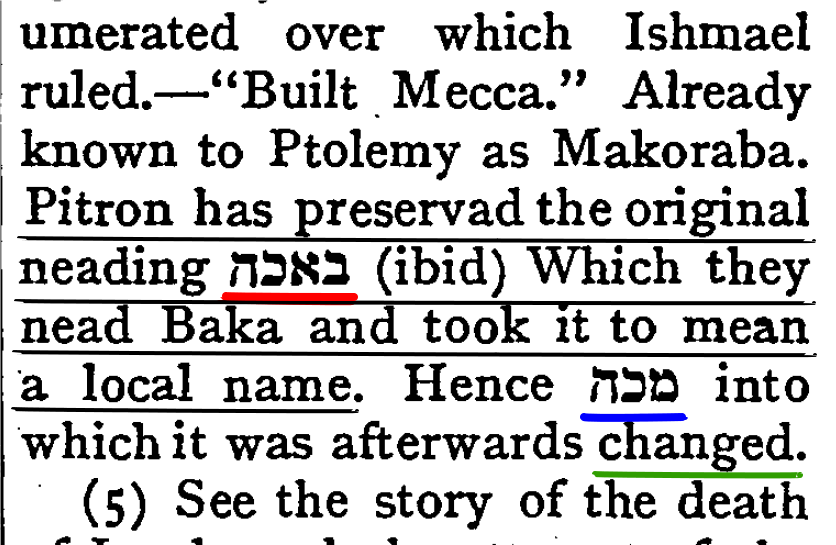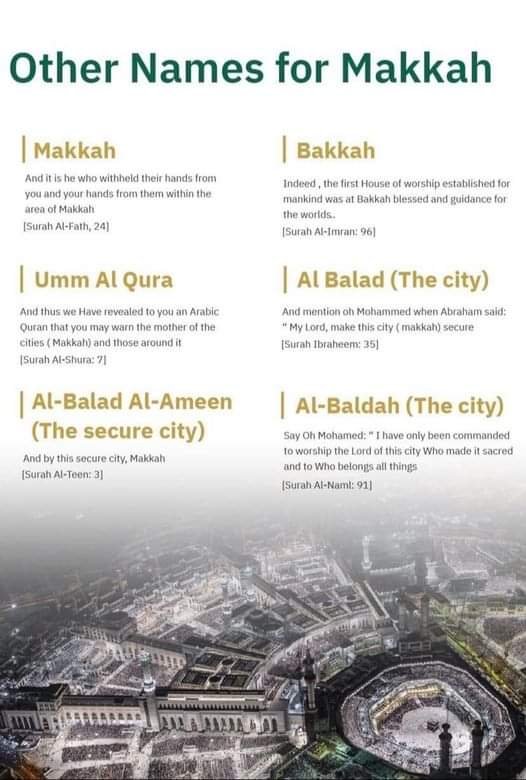𝐄𝐯𝐢𝐝𝐞𝐧𝐜𝐞 𝐌𝐞𝐜𝐜𝐚 𝐞𝐱𝐢𝐬𝐭𝐞𝐝 𝐝𝐮𝐫𝐢𝐧𝐠 𝐭𝐡𝐞 𝐭𝐢𝐦𝐞 𝐨𝐟 𝐫𝐞𝐯𝐞𝐚𝐥𝐢𝐧𝐠 𝐭𝐡𝐞 𝐓𝐨𝐫𝐚𝐡 𝐭𝐨 𝐩𝐫𝐨𝐩𝐡𝐞𝐭 𝐌𝐨𝐬𝐞𝐬
Mohamad Mostafa Nassar
Twitter:@NassarMohamadMR
𝐇𝐢𝐬𝐭𝐨𝐫𝐢𝐚𝐥 𝐏𝐫𝐨𝐨𝐟 𝐌𝐞𝐜𝐜𝐚’𝐬 𝐄𝐱𝐢𝐬𝐭𝐞𝐧𝐜𝐞 𝐁.𝐂.
𝐏𝐨𝐰𝐞𝐫𝐟𝐮𝐥 𝐩𝐫𝐨𝐨𝐟 𝐭𝐡𝐚𝐭 𝐌𝐞𝐜𝐜𝐚 𝐚𝐥𝐫𝐞𝐚𝐝𝐲 𝐞𝐱𝐢𝐬𝐭𝐞𝐝 𝐚𝐬 𝐚 𝐜𝐢𝐭𝐲 𝐚𝐭 𝐭𝐡𝐞 𝐭𝐢𝐦𝐞 𝐨𝐟 𝐫𝐞𝐯𝐞𝐚𝐥𝐢𝐧𝐠 𝐭𝐡𝐞 𝐓𝐨𝐫𝐚𝐡 𝐭𝐨 𝐭𝐡𝐞 𝐩𝐫𝐨𝐩𝐡𝐞𝐭 𝐌𝐨𝐬𝐞𝐬 (𝐩𝐛𝐮𝐡).
[𝐍𝐎𝐓𝐄: 𝐭𝐡𝐞 𝐛𝐞𝐥𝐨𝐰 𝐢𝐧𝐟𝐨 𝐚𝐫𝐞 𝐚𝐧 𝐞𝐱𝐜𝐞𝐫𝐩𝐭𝐬 𝐟𝐫𝐨𝐦 𝐦𝐲 𝐩𝐨𝐥𝐢𝐬𝐡 𝐛𝐨𝐨𝐤 𝐞𝐧𝐭𝐢𝐭𝐥𝐞𝐝 “𝐙𝐧𝐚𝐤𝐢 𝐢 𝐩𝐫𝐨𝐫𝐨𝐜𝐭𝐰𝐚 𝐒𝐭𝐚𝐫𝐞𝐠𝐨 𝐓𝐞𝐬𝐭𝐚𝐦𝐞𝐧𝐭𝐮 𝐨 𝐧𝐚𝐝𝐞𝐣𝐬́𝐜𝐢𝐮 𝐎𝐬𝐭𝐚𝐭𝐧𝐢𝐞𝐠𝐨 𝐏𝐨𝐬ł𝐚𝐧́𝐜𝐚 𝐁𝐨𝐠𝐚”]
𝐓𝐨𝐝𝐚𝐲, 𝐯𝐞𝐫𝐲 𝐟𝐞𝐰 𝐌𝐮𝐬𝐥𝐢𝐦𝐬 𝐚𝐧𝐝 𝐂𝐡𝐫𝐢𝐬𝐭𝐢𝐚𝐧𝐬 𝐚𝐥𝐢𝐤𝐞 𝐚𝐫𝐞 𝐚𝐰𝐚𝐫𝐞 𝐨𝐟 𝐭𝐡𝐚𝐭 𝐌𝐞𝐜𝐜𝐚 – 𝐚𝐥𝐨𝐧𝐠 𝐰𝐢𝐭𝐡 𝐌𝐞𝐝𝐢𝐧𝐚 – 𝐢𝐬 𝐞𝐱𝐩𝐥𝐢𝐜𝐢𝐭𝐥𝐲 𝐦𝐞𝐧𝐭𝐢𝐨𝐧𝐞𝐝 𝐛𝐲 𝐧𝐚𝐦𝐞 𝐢𝐧 𝐚𝐧 𝐞𝐚𝐫𝐥𝐲 𝐫𝐚𝐛𝐛𝐢𝐧𝐢𝐜 𝐭𝐫𝐚𝐧𝐬𝐥𝐚𝐭𝐢𝐨𝐧 𝐨𝐟 𝐭𝐡𝐞 𝐏𝐞𝐧𝐭𝐚𝐭𝐞𝐮𝐜𝐡.
𝐈𝐧 𝐆𝐞𝐧𝐞𝐬𝐢𝐬 𝟏𝟎:𝟑𝟎 𝐚𝐜𝐜𝐨𝐫𝐝𝐢𝐧𝐠 𝐭𝐨 𝐭𝐡𝐞 𝐌𝐚𝐬𝐨𝐫𝐞𝐭𝐢𝐜 𝐓𝐞𝐱𝐭 𝐰𝐞 𝐫𝐞𝐚𝐝 𝐭𝐡𝐞 𝐟𝐨𝐥𝐥𝐨𝐰𝐢𝐧𝐠:
“𝐀𝐧𝐝 𝐭𝐡𝐞𝐢𝐫 𝐝𝐰𝐞𝐥𝐥𝐢𝐧𝐠 𝐰𝐚𝐬 𝐟𝐫𝐨𝐦 𝐌𝐞𝐬𝐡𝐚, 𝐚𝐬 𝐭𝐡𝐨𝐮 𝐠𝐨𝐞𝐬𝐭 𝐭𝐨𝐰𝐚𝐫𝐝 𝐒𝐞𝐩𝐡𝐚𝐫, 𝐮𝐧𝐭𝐨 𝐭𝐡𝐞 𝐦𝐨𝐮𝐧𝐭𝐚𝐢𝐧 𝐨𝐟 𝐭𝐡𝐞 𝐞𝐚𝐬𝐭.” [𝐉𝐏𝐒, 𝟏𝟗𝟏𝟕]
𝐇𝐨𝐰𝐞𝐯𝐞𝐫, 𝐭𝐡𝐞 𝐚𝐛𝐨𝐯𝐞 𝐩𝐚𝐬𝐬𝐚𝐠𝐞 𝐚𝐜𝐜𝐨𝐫𝐝𝐢𝐧𝐠 𝐭𝐨 𝐭𝐡𝐞 𝐉𝐮𝐝𝐞𝐨-𝐀𝐫𝐚𝐛𝐢𝐜 𝐭𝐫𝐚𝐧𝐬𝐥𝐚𝐭𝐢𝐨𝐧 – 𝐢.𝐞. 𝐭𝐡𝐞 𝐩𝐫𝐨𝐜𝐞𝐬𝐬 𝐨𝐟 𝐫𝐞𝐚𝐝𝐢𝐧𝐠 𝐫𝐮𝐧𝐬 𝐚𝐬 𝐢𝐧 𝐀𝐫𝐚𝐛𝐢𝐜, 𝐛𝐮𝐭 𝐭𝐡𝐞 𝐬𝐜𝐫𝐢𝐩𝐭 𝐢𝐬 𝐰𝐫𝐢𝐭𝐭𝐞𝐧 𝐰𝐢𝐭𝐡 𝐇𝐞𝐛𝐫𝐞𝐰 𝐥𝐞𝐭𝐭𝐞𝐫𝐬 –
𝐌𝐚𝐝𝐞 𝐛𝐲 𝐑𝐚𝐛𝐛𝐢 𝐒𝐚𝐚𝐝𝐢𝐚 𝐛𝐞𝐧 𝐉𝐨𝐬𝐞𝐩𝐡 𝐚𝐥-𝐅𝐚𝐲𝐲𝐮𝐦𝐢 (𝐜𝐚. 𝟖𝟖𝟐-𝟗𝟒𝟐), 𝐚𝐥𝐬𝐨 𝐤𝐧𝐨𝐰𝐧 𝐚𝐬 𝐒𝐚𝐚𝐝𝐢𝐚 𝐆𝐚𝐨𝐧, 𝐫𝐞𝐚𝐝𝐬 𝐚𝐬:

𝐓𝐫𝐚𝐧𝐬𝐥𝐚𝐭𝐢𝐨𝐧:
“𝐀𝐧𝐝 𝐭𝐡𝐞𝐢𝐫 𝐝𝐰𝐞𝐥𝐥𝐢𝐧𝐠 𝐰𝐚𝐬 𝐟𝐫𝐨𝐦 𝐌𝐞𝐜𝐜𝐚 𝐭𝐨𝐰𝐚𝐫𝐝𝐬 𝐚𝐥-𝐌𝐞𝐝𝐢𝐧𝐚, 𝐮𝐧𝐭𝐨 𝐭𝐡𝐞 𝐦𝐨𝐮𝐧𝐭𝐚𝐢𝐧 𝐨𝐟 𝐭𝐡𝐞 𝐄𝐚𝐬𝐭.” [Œ𝐮𝐯𝐫𝐞𝐬 𝐜𝐨𝐦𝐩𝐥𝐞̀𝐭𝐞𝐬 𝐝𝐞 𝐑. 𝐒𝐚𝐚𝐝𝐢𝐚 𝐛𝐞𝐧 𝐈𝐨𝐬𝐞𝐟 𝐚𝐥-𝐅𝐚𝐲𝐲𝐨𝐮̂𝐦𝐢̂, 𝐞𝐝. 𝐛𝐲 𝐉. 𝐃𝐚𝐫𝐞𝐧𝐛𝐨𝐮𝐫𝐠, 𝐯𝐨𝐥. 𝟏 (𝐏𝐚𝐫𝐢𝐬: 𝐄. 𝐋𝐞𝐫𝐨𝐮𝐱, 𝟏𝟖𝟗𝟑), 𝐩. 𝟏𝟕.]
𝐄𝐯𝐞𝐫𝐲𝐨𝐧𝐞 𝐰𝐡𝐨 𝐢𝐬 𝐟𝐚𝐦𝐢𝐥𝐢𝐚𝐫 𝐰𝐢𝐭𝐡 𝐇𝐞𝐛𝐫𝐞𝐰 𝐰𝐢𝐥𝐥 𝐧𝐨𝐭 𝐜𝐨𝐧𝐭𝐫𝐚𝐝𝐢𝐜𝐭 𝐦𝐞 𝐢𝐧 𝐭𝐡𝐢𝐬 𝐦𝐚𝐭𝐭𝐞𝐫 (𝐌𝐞𝐤𝐤𝐚 𝐰𝐚𝐬 𝐦𝐚𝐫𝐤𝐞𝐝 𝐰𝐢𝐭𝐡 𝐛𝐥𝐮𝐞 𝐜𝐨𝐥𝐨𝐫, 𝐚𝐥-𝐌𝐞𝐝𝐢𝐧𝐚 𝐰𝐢𝐭𝐡 𝐫𝐞𝐝 𝐜𝐨𝐥𝐨𝐫).
𝐅𝐢𝐫𝐬𝐭 𝐨𝐟 𝐚𝐥𝐥, 𝐒𝐚𝐚𝐝𝐢𝐚 𝐆𝐚𝐨𝐧 𝐢𝐬 𝐨𝐧𝐞 𝐨𝐟 𝐭𝐡𝐞 𝐦𝐨𝐬𝐭 𝐩𝐫𝐨𝐦𝐢𝐧𝐞𝐧𝐭 𝐉𝐞𝐰𝐢𝐬𝐡 𝐬𝐜𝐡𝐨𝐥𝐚𝐫𝐬, 𝐚𝐧𝐝 𝐢𝐭 𝐢𝐬 𝐬𝐚𝐢𝐝 𝐭𝐡𝐚𝐭 𝐡𝐢𝐬 𝐭𝐫𝐚𝐧𝐬𝐥𝐚𝐭𝐢𝐨𝐧 𝐡𝐨𝐥𝐝𝐬 𝐚𝐧 𝐮𝐧𝐜𝐡𝐚𝐥𝐥𝐞𝐧𝐠𝐞𝐚𝐛𝐥𝐞 𝐚𝐮𝐭𝐡𝐨𝐫𝐢𝐭𝐲 𝐨𝐯𝐞𝐫 𝐚𝐥𝐥 𝐨𝐭𝐡𝐞𝐫 𝐛𝐢𝐛𝐥𝐢𝐜𝐚𝐥 𝐭𝐫𝐚𝐧𝐬𝐥𝐚𝐭𝐢𝐨𝐧𝐬 𝐬𝐢𝐧𝐜𝐞 𝐡𝐞 𝐰𝐚𝐬 𝐭𝐡𝐞 𝐛𝐞𝐬𝐭, 𝐞𝐬𝐩𝐞𝐜𝐢𝐚𝐥𝐥𝐲 𝐢𝐧 𝐬𝐜𝐫𝐢𝐩𝐭𝐮𝐫𝐚𝐥 𝐞𝐱𝐞𝐠𝐞𝐬𝐢𝐬, 𝐉𝐞𝐰𝐢𝐬𝐡 𝐡𝐢𝐬𝐭𝐨𝐫𝐲, 𝐚𝐧𝐝 𝐓𝐚𝐥𝐦𝐮𝐝𝐢𝐜 𝐤𝐧𝐨𝐰𝐥𝐞𝐝𝐠𝐞 𝐢𝐧 𝐠𝐞𝐧𝐞𝐫𝐚𝐥, 𝐚𝐧𝐝 𝐡𝐞 𝐢𝐬 𝐫𝐞𝐬𝐩𝐨𝐧𝐬𝐢𝐛𝐥𝐞 𝐟𝐨𝐫 𝐭𝐡𝐞 𝐟𝐢𝐫𝐬𝐭 𝐚𝐧𝐝 𝐦𝐨𝐬𝐭 𝐢𝐦𝐩𝐨𝐫𝐭𝐚𝐧𝐭 𝐀𝐫𝐚𝐛𝐢𝐜 𝐭𝐫𝐚𝐧𝐬𝐥𝐚𝐭𝐢𝐨𝐧 𝐨𝐟 𝐭𝐡𝐞 𝐓𝐨𝐫𝐚𝐡 𝐰𝐡𝐢𝐜𝐡 𝐛𝐞𝐜𝐚𝐦𝐞 𝐭𝐡𝐞 𝐬𝐭𝐚𝐧𝐝𝐚𝐫𝐝 𝐯𝐞𝐫𝐬𝐢𝐨𝐧 𝐟𝐨𝐫 𝐚𝐥𝐥 𝐉𝐞𝐰𝐬 𝐥𝐢𝐯𝐢𝐧𝐠 𝐢𝐧 𝐌𝐮𝐬𝐥𝐢𝐦 𝐜𝐨𝐮𝐧𝐭𝐫𝐢𝐞𝐬.
𝐌𝐚𝐢𝐦𝐨𝐧𝐢𝐝𝐞𝐬 𝐡𝐢𝐦𝐬𝐞𝐥𝐟, 𝐚 𝐠𝐫𝐞𝐚𝐭 𝐚𝐧𝐝 𝐫𝐞𝐬𝐩𝐞𝐜𝐭𝐞𝐝 𝐑𝐚𝐛𝐛𝐢 (𝟏𝟏𝟑𝟓-𝟏𝟐𝟎𝟒) 𝐬𝐚𝐢𝐝:
“𝐰𝐞𝐫𝐞 𝐢𝐭 𝐧𝐨𝐭 𝐟𝐨𝐫 𝐒𝐚𝐚𝐝𝐢𝐚, 𝐭𝐡𝐞 𝐓𝐨𝐫𝐚𝐡 𝐰𝐨𝐮𝐥𝐝 𝐚𝐥𝐦𝐨𝐬𝐭 𝐡𝐚𝐯𝐞 𝐝𝐢𝐬𝐚𝐩𝐩𝐞𝐚𝐫𝐞𝐝 𝐟𝐫𝐨𝐦 𝐭𝐡𝐞 𝐦𝐢𝐝𝐬𝐭 𝐨𝐟 𝐈𝐬𝐫𝐚𝐞𝐥; 𝐟𝐨𝐫 𝐢𝐭 𝐰𝐚𝐬 𝐡𝐞 𝐰𝐡𝐨 𝐦𝐚𝐝𝐞 𝐦𝐚𝐧𝐢𝐟𝐞𝐬𝐭 𝐰𝐡𝐚𝐭 𝐰𝐚𝐬 𝐨𝐛𝐬𝐜𝐮𝐫𝐞 𝐭𝐡𝐞𝐫𝐞𝐢𝐧 𝐦𝐚𝐝𝐞 𝐬𝐭𝐫𝐨𝐧𝐠 𝐰𝐡𝐚𝐭 𝐡𝐚𝐝 𝐛𝐞𝐞𝐧 𝐰𝐞𝐚𝐤𝐞𝐧𝐞𝐝, 𝐚𝐧𝐝 𝐦𝐚𝐝𝐞 𝐢𝐭 𝐤𝐧𝐨𝐰𝐧 𝐟𝐚𝐫 𝐚𝐧𝐝 𝐰𝐢𝐝𝐞 𝐛𝐲 𝐰𝐨𝐫𝐝 𝐨𝐟 𝐦𝐨𝐮𝐭𝐡 𝐚𝐧𝐝 𝐢𝐧 𝐰𝐫𝐢𝐭𝐢𝐧𝐠.” [𝐇. 𝐌𝐚𝐥𝐭𝐞𝐫, 𝐒𝐚𝐚𝐝𝐢𝐚 𝐆𝐚𝐨𝐧: 𝐇𝐢𝐬 𝐋𝐢𝐟𝐞 𝐚𝐧𝐝 𝐖𝐨𝐫𝐤𝐬, (𝐏𝐡𝐢𝐥𝐚𝐝𝐞𝐥𝐩𝐡𝐢𝐚: 𝐓𝐡𝐞 𝐉𝐞𝐰𝐢𝐬𝐡 𝐏𝐮𝐛𝐥𝐢𝐜𝐚𝐭𝐢𝐨𝐧 𝐒𝐨𝐜𝐢𝐞𝐭𝐲 𝐨𝐟 𝐀𝐦𝐞𝐫𝐢𝐜𝐚, 𝟏𝟗𝟐𝟏), 𝐩. 𝟐𝟕𝟗.]
𝐓𝐡𝐞𝐫𝐞𝐟𝐨𝐫𝐞, 𝐚𝐬 𝐲𝐨𝐮 𝐜𝐚𝐧 𝐬𝐞𝐞, 𝐡𝐢𝐬 𝐭𝐫𝐚𝐧𝐬𝐥𝐚𝐭𝐢𝐨𝐧 𝐢𝐬 𝐚 𝐩𝐫𝐢𝐦𝐚𝐫𝐲 𝐬𝐨𝐮𝐫𝐜𝐞 𝐰𝐡𝐞𝐧 𝐢𝐭 𝐜𝐨𝐦𝐞𝐬 𝐭𝐨 𝐭𝐡𝐞 𝐚𝐜𝐜𝐮𝐫𝐚𝐜𝐲 𝐨𝐟 𝐎𝐥𝐝 𝐓𝐞𝐬𝐭𝐚𝐦𝐞𝐧𝐭 𝐢𝐧𝐭𝐞𝐫𝐩𝐫𝐞𝐭𝐚𝐭𝐢𝐨𝐧. 𝐀𝐬 𝐭𝐨 𝐭𝐡𝐞 𝐦𝐞𝐧𝐭𝐢𝐨𝐧𝐢𝐧𝐠 𝐨𝐟 𝐌𝐞𝐜𝐜𝐚 𝐚𝐧𝐝 𝐌𝐞𝐝𝐢𝐧𝐚 𝐢𝐧 𝐆𝐞𝐧𝐞𝐬𝐢𝐬.
𝐋𝐞𝐭 𝐮𝐬 𝐫𝐞𝐜𝐚𝐥𝐥 𝐞.𝐠. 𝐭𝐡𝐞 𝐬𝐭𝐚𝐭𝐞𝐦𝐞𝐧𝐭 𝐨𝐟 𝐭𝐡𝐞 𝐑𝐞𝐯. 𝐏𝐫𝐨𝐟𝐞𝐬𝐬𝐨𝐫 𝐖𝐢𝐥𝐥𝐢𝐚𝐦 𝐏𝐚𝐮𝐥 𝐰𝐡𝐨 𝐢𝐧 𝐡𝐢𝐬 𝐜𝐫𝐢𝐭𝐢𝐜𝐚𝐥 𝐢𝐧𝐭𝐞𝐫𝐩𝐫𝐞𝐭𝐚𝐭𝐢𝐨𝐧 𝐭𝐨 𝐭𝐡𝐞 𝐇𝐞𝐛𝐫𝐞𝐰 𝐟𝐫𝐚𝐠𝐦𝐞𝐧𝐭 הַקֶּדֶם הַר [#𝟗𝟗𝟔] 𝐟𝐫𝐨𝐦 𝐆𝐞𝐧𝐞𝐬𝐢𝐬 𝟏𝟎:𝟑𝟎, 𝐡𝐚𝐬 𝐰𝐫𝐨𝐭𝐞: “𝐦𝐨𝐮𝐧𝐭𝐚𝐢𝐧 (𝐦𝐨𝐮𝐧𝐭𝐚𝐢𝐧𝐬) 𝐨𝐟 𝐭𝐡𝐞 𝐄𝐚𝐬𝐭.
𝐓𝐡𝐞𝐬𝐞 𝐚𝐫𝐞 𝐬𝐮𝐩𝐩𝐨𝐬𝐞𝐝 𝐭𝐨 𝐛𝐞 𝐭𝐡𝐨𝐬𝐞 𝐦𝐨𝐮𝐧𝐭𝐚𝐢𝐧𝐬 𝐨𝐟 𝐀𝐫𝐚𝐛𝐢𝐚 𝐫𝐮𝐧𝐧𝐢𝐧𝐠 𝐟𝐫𝐨𝐦 𝐭𝐡𝐞 𝐧𝐞𝐢𝐠𝐡𝐛𝐨𝐫𝐡𝐨𝐨𝐝 𝐨𝐟 𝐌𝐞𝐜𝐜𝐚 𝐚𝐧𝐝 𝐌𝐞𝐝𝐢𝐧𝐚 𝐭𝐨 𝐭𝐡𝐞 𝐏𝐞𝐫𝐬𝐢𝐚𝐧 𝐆𝐮𝐥𝐟.” [𝐑𝐞𝐯. 𝐖. 𝐏𝐚𝐮𝐥, 𝐀𝐧𝐚𝐥𝐲𝐬𝐢𝐬 𝐚𝐧𝐝 𝐜𝐫𝐢𝐭𝐢𝐜𝐚𝐥 𝐢𝐧𝐭𝐞𝐫𝐩𝐫𝐞𝐭𝐚𝐭𝐢𝐨𝐧 𝐨𝐟 𝐭𝐡𝐞 𝐇𝐞𝐛𝐫𝐞𝐰 𝐭𝐞𝐱𝐭 𝐨𝐟 𝐭𝐡𝐞 𝐁𝐨𝐨𝐤 𝐨𝐟 𝐆𝐞𝐧𝐞𝐬𝐢𝐬, (𝐄𝐝𝐢𝐧𝐛𝐮𝐫𝐠𝐡: 𝐖. 𝐁𝐥𝐚𝐜𝐤𝐰𝐨𝐨𝐝 & 𝐒𝐨𝐧𝐬, 𝟏𝟖𝟓𝟐), 𝐩. 𝟏𝟎𝟎.]
𝐎𝐭𝐡𝐞𝐫 𝐬𝐜𝐡𝐨𝐥𝐚𝐫𝐬 𝐚𝐥𝐬𝐨 𝐬𝐡𝐚𝐫𝐞 𝐚 𝐬𝐢𝐦𝐢𝐥𝐚𝐫 𝐯𝐢𝐞𝐰. 𝐓𝐡𝐢𝐬 𝐨𝐟 𝐜𝐨𝐮𝐫𝐬𝐞 𝐞𝐱𝐩𝐥𝐚𝐢𝐧𝐬 𝐰𝐡𝐲 𝐫𝐚𝐛𝐛𝐢 𝐒𝐚𝐚𝐝𝐢𝐚 𝐆𝐚𝐨𝐧 𝐡𝐚𝐬 𝐦𝐞𝐧𝐭𝐢𝐨𝐧𝐞𝐝 𝐌𝐞𝐜𝐜𝐚 𝐚𝐧𝐝 𝐌𝐞𝐝𝐢𝐧𝐚 𝐢𝐧 𝐆𝐞𝐧𝐞𝐬𝐢𝐬 𝟏𝟎:𝟑𝟎. 𝐓𝐡𝐢𝐬 𝐢𝐬 𝐧𝐨𝐭 𝐨𝐧𝐥𝐲 𝐡𝐢𝐬 𝐩𝐚𝐫𝐚𝐩𝐡𝐫𝐚𝐬𝐞 𝐜𝐨𝐧𝐜𝐥𝐮𝐝𝐞𝐝 𝐟𝐫𝐨𝐦 𝐭𝐡𝐞 𝐜𝐨𝐧𝐭𝐞𝐱𝐭 𝐚𝐬 𝐬𝐨𝐦𝐞 𝐦𝐢𝐠𝐡𝐭 𝐭𝐡𝐢𝐧𝐤 𝐛𝐞𝐜𝐚𝐮𝐬𝐞 𝐢𝐟 𝐲𝐨𝐮 𝐠𝐨 𝐭𝐨 𝐭𝐡𝐞 𝐇𝐞𝐛𝐫𝐞𝐰 𝐭𝐞𝐱𝐭 𝐲𝐨𝐮 𝐰𝐢𝐥𝐥 𝐧𝐨𝐭𝐢𝐜𝐞 𝐭𝐡𝐞𝐫𝐞 𝐬𝐮𝐜𝐡 𝐰𝐨𝐫𝐝𝐬 𝐚𝐬 באכה (𝐛𝐚𝐤𝐚) 𝐰𝐡𝐢𝐜𝐡 𝐰𝐚𝐬 𝐭𝐫𝐚𝐧𝐬𝐥𝐚𝐭𝐞𝐝 𝐚𝐬 “𝐚𝐬 𝐭𝐡𝐨𝐮 𝐠𝐨𝐞𝐬𝐭” !
𝐎𝐭𝐡𝐞𝐫 𝐬𝐜𝐡𝐨𝐥𝐚𝐫𝐬 𝐚𝐥𝐬𝐨 𝐬𝐡𝐚𝐫𝐞 𝐚 𝐬𝐢𝐦𝐢𝐥𝐚𝐫 𝐯𝐢𝐞𝐰. 𝐓𝐡𝐢𝐬 𝐨𝐟 𝐜𝐨𝐮𝐫𝐬𝐞 𝐞𝐱𝐩𝐥𝐚𝐢𝐧𝐬 𝐰𝐡𝐲 𝐫𝐚𝐛𝐛𝐢 𝐒𝐚𝐚𝐝𝐢𝐚 𝐆𝐚𝐨𝐧 𝐡𝐚𝐬 𝐦𝐞𝐧𝐭𝐢𝐨𝐧𝐞𝐝 𝐌𝐞𝐜𝐜𝐚 𝐚𝐧𝐝 𝐌𝐞𝐝𝐢𝐧𝐚 𝐢𝐧 𝐆𝐞𝐧𝐞𝐬𝐢𝐬 𝟏𝟎:𝟑𝟎. 𝐓𝐡𝐢𝐬 𝐢𝐬 𝐧𝐨𝐭 𝐨𝐧𝐥𝐲 𝐡𝐢𝐬 𝐩𝐚𝐫𝐚𝐩𝐡𝐫𝐚𝐬𝐞 𝐜𝐨𝐧𝐜𝐥𝐮𝐝𝐞𝐝 𝐟𝐫𝐨𝐦 𝐭𝐡𝐞 𝐜𝐨𝐧𝐭𝐞𝐱𝐭 𝐚𝐬 𝐬𝐨𝐦𝐞 𝐦𝐢𝐠𝐡𝐭 𝐭𝐡𝐢𝐧𝐤 𝐛𝐞𝐜𝐚𝐮𝐬𝐞 𝐢𝐟 𝐲𝐨𝐮 𝐠𝐨 𝐭𝐨 𝐭𝐡𝐞 𝐇𝐞𝐛𝐫𝐞𝐰 𝐭𝐞𝐱𝐭 𝐲𝐨𝐮 𝐰𝐢𝐥𝐥 𝐧𝐨𝐭𝐢𝐜𝐞 𝐭𝐡𝐞𝐫𝐞 𝐬𝐮𝐜𝐡 𝐰𝐨𝐫𝐝𝐬 𝐚𝐬 באכה (𝐛𝐚𝐤𝐚) 𝐰𝐡𝐢𝐜𝐡 𝐰𝐚𝐬 𝐭𝐫𝐚𝐧𝐬𝐥𝐚𝐭𝐞𝐝 𝐚𝐬 “𝐚𝐬 𝐭𝐡𝐨𝐮 𝐠𝐨𝐞𝐬𝐭”!
ויהי מושׁבם ממשׁא באכה ספרה הר הקדם
𝐎𝐧 𝐭𝐡𝐚𝐭 𝐨𝐜𝐜𝐚𝐬𝐢𝐨𝐧 𝐢𝐭 𝐦𝐮𝐬𝐭 𝐛𝐞 𝐬𝐭𝐫𝐞𝐬𝐬𝐞𝐝 𝐭𝐡𝐚𝐭 𝐭𝐡𝐞 𝐇𝐞𝐛𝐫𝐞𝐰 משׁא (𝐌𝐞𝐬𝐡𝐚), 𝐭𝐡𝐚𝐭 𝐩𝐫𝐞𝐜𝐞𝐝𝐬 באכה, 𝐝𝐨𝐞𝐬 𝐧𝐨𝐭 𝐬𝐭𝐚𝐧𝐝 𝐡𝐞𝐫𝐞 𝐟𝐨𝐫 𝐌𝐞𝐜𝐜𝐚 𝐚𝐬 𝐬𝐨𝐦𝐞 𝐨𝐟 𝐲𝐨𝐮 𝐰𝐨𝐮𝐥𝐝 𝐬𝐮𝐩𝐩𝐨𝐬𝐞.
𝐋𝐞𝐱𝐢𝐜𝐨𝐧𝐬 𝐬𝐚𝐲𝐬 𝐭𝐡𝐚𝐭 𝐭𝐡𝐢𝐬 𝐰𝐨𝐫𝐝 𝐢𝐬 𝐨𝐟 𝐟𝐨𝐫𝐞𝐢𝐠𝐧 𝐝𝐞𝐫𝐢𝐯𝐚𝐭𝐢𝐨𝐧, 𝐚𝐧𝐝 𝐭𝐡𝐞𝐫𝐞 𝐢𝐬 𝐧𝐨 𝐜𝐨𝐧𝐬𝐞𝐧𝐬𝐮𝐬 𝐚𝐬 𝐭𝐨 𝐰𝐡𝐞𝐭𝐡𝐞𝐫 𝐢𝐭 𝐫𝐞𝐟𝐞𝐫𝐬 𝐭𝐨 𝐚 𝐩𝐥𝐚𝐜𝐞 𝐬𝐨𝐦𝐞𝐰𝐡𝐞𝐫𝐞 𝐢𝐧 𝐀𝐫𝐚𝐛𝐢𝐚, 𝐨𝐫 𝐭𝐨 𝐚 𝐫𝐞𝐠𝐢𝐨𝐧, 𝐨𝐫 𝐭𝐨 𝐚 𝐧𝐨𝐫𝐭𝐡 𝐀𝐫𝐚𝐛𝐢𝐚𝐧 𝐭𝐫𝐢𝐛𝐞.
𝐈𝐧 𝐚𝐧𝐲 𝐜𝐚𝐬𝐞, 𝐰𝐞 𝐡𝐚𝐯𝐞 𝐭𝐨 𝐜𝐨𝐧𝐜𝐞𝐧𝐭𝐫𝐚𝐭𝐞 𝐨𝐧 באכה (𝐛𝐚𝐤𝐚𝐡), 𝐚𝐧𝐝 𝐢𝐭 𝐰𝐨𝐮𝐥𝐝 𝐛𝐞 𝐪𝐮𝐢𝐭𝐞 𝐩𝐫𝐞𝐟𝐞𝐫𝐚𝐛𝐥𝐞 𝐭𝐨 𝐫𝐞𝐦𝐞𝐦𝐛𝐞𝐫 𝐭𝐡𝐢𝐬 𝐰𝐨𝐫𝐝 𝐢𝐧 𝐢𝐭𝐬 𝐞𝐱𝐚𝐜𝐭 𝐇𝐞𝐛𝐫𝐞𝐰 𝐟𝐨𝐫𝐦 𝐟𝐨𝐫 𝐭𝐡𝐞 𝐧𝐞𝐱𝐭 𝐩𝐨𝐫𝐭𝐢𝐨𝐧 𝐨𝐟 𝐢𝐧𝐟𝐨𝐫𝐦𝐚𝐭𝐢𝐨𝐧.
𝐓𝐡𝐞 𝐬𝐞𝐜𝐨𝐧𝐝 𝐩𝐫𝐨𝐨𝐟 𝐭𝐡𝐚𝐭 𝐀𝐥𝐥𝐚𝐡 𝐀𝐥𝐦𝐢𝐠𝐡𝐭𝐲 𝐥𝐞𝐭 𝐦𝐞 𝐭𝐨 𝐝𝐢𝐬𝐜𝐨𝐯𝐞𝐫 𝐜𝐨𝐦𝐞𝐬 𝐟𝐫𝐨𝐦 𝐚 𝐫𝐚𝐫𝐞 𝐛𝐨𝐨𝐤 𝐜𝐚𝐥𝐥𝐞𝐝 𝐓𝐡𝐞 𝐀𝐬𝐚𝐭𝐢𝐫: 𝐓𝐡𝐞 𝐒𝐚𝐦𝐚𝐫𝐢𝐭𝐚𝐧 𝐁𝐨𝐨𝐤 𝐨𝐟 𝐭𝐡𝐞 𝐒𝐞𝐜𝐫𝐞𝐭𝐬 𝐨𝐟 𝐌𝐨𝐬𝐞𝐬 𝐰𝐡𝐢𝐜𝐡 𝐰𝐚𝐬 𝐭𝐫𝐚𝐧𝐬𝐥𝐚𝐭𝐞𝐝 𝐚𝐧𝐝 𝐩𝐮𝐛𝐥𝐢𝐬𝐡𝐞𝐝 𝐛𝐲 𝐃𝐫. 𝐌𝐨𝐬𝐞𝐬 𝐆𝐚𝐬𝐭𝐞𝐫 𝐢𝐧 𝟏𝟗𝟐𝟕.
𝐓𝐡𝐢𝐬 𝐚𝐧𝐜𝐢𝐞𝐧𝐭 𝐝𝐨𝐜𝐮𝐦𝐞𝐧𝐭 𝐚𝐜𝐜𝐨𝐫𝐝𝐢𝐧𝐠 𝐭𝐨 𝐃𝐫. 𝐌𝐨𝐬𝐞𝐬 𝐢𝐬 𝐦𝐮𝐜𝐡 𝐨𝐥𝐝𝐞𝐫 𝐭𝐡𝐚𝐧 𝐉𝐨𝐬𝐞𝐩𝐡𝐮𝐬 𝐨𝐫 𝐭𝐡𝐞 𝐏𝐚𝐥𝐞𝐬𝐭𝐢𝐧𝐢𝐚𝐧 𝐓𝐚𝐫𝐠𝐮𝐦, 𝐚𝐧𝐝 𝐚𝐟𝐭𝐞𝐫 𝐜𝐨𝐦𝐩𝐚𝐫𝐢𝐧𝐠 𝐢𝐭 𝐰𝐢𝐭𝐡 𝐭𝐡𝐞 𝐨𝐭𝐡𝐞𝐫 𝐦𝐚𝐧𝐮𝐬𝐜𝐫𝐢𝐩𝐭𝐬 𝐚𝐬𝐬𝐮𝐦𝐞𝐬 𝐭𝐡𝐚𝐭 𝐭𝐡𝐢𝐬 𝐛𝐨𝐨𝐤 𝐜𝐨𝐮𝐥𝐝 𝐧𝐨𝐭 𝐡𝐚𝐯𝐞 𝐛𝐞𝐞𝐧 𝐜𝐨𝐦𝐩𝐢𝐥𝐞𝐝 𝐥𝐚𝐭𝐞𝐫 𝐭𝐡𝐚𝐧 𝐛𝐞𝐭𝐰𝐞𝐞𝐧 𝟐𝟓𝟎-𝟐𝟎𝟎 𝐁.𝐂. 𝐈𝐧 𝐂𝐡𝐚𝐩𝐭𝐞𝐫 𝐕𝐈𝐈𝐈 𝐨𝐟 𝐭𝐡𝐢𝐬 𝐛𝐨𝐨𝐤, 𝐰𝐞 𝐫𝐞𝐚𝐝:

𝐍𝐨 𝐜𝐨𝐦𝐦𝐞𝐧𝐭… 𝐲𝐨𝐮 𝐡𝐚𝐯𝐞 𝐜𝐫𝐲𝐬𝐭𝐚𝐥 𝐜𝐥𝐞𝐚𝐫 𝐩𝐫𝐨𝐨𝐟! 𝐁𝐮𝐭 𝐥𝐞𝐭’𝐬 𝐫𝐞𝐚𝐝 𝐰𝐡𝐚𝐭 𝐃𝐫. 𝐌𝐨𝐬𝐞𝐬 𝐬𝐚𝐢𝐝 𝐢𝐧 𝐡𝐢𝐬 𝐜𝐨𝐦𝐦𝐞𝐧𝐭𝐚𝐫𝐲 𝐭𝐨 𝐭𝐡𝐞 𝐥𝐚𝐬𝐭 𝐟𝐫𝐚𝐠𝐦𝐞𝐧𝐭 “𝐁𝐮𝐢𝐥𝐭 𝐌𝐞𝐜𝐜𝐚” 𝐨𝐟 𝐯𝐞𝐫𝐬𝐞 𝟑:

𝐍𝐨𝐭𝐞:
𝐈𝐧 𝐭𝐡𝐞 𝐚𝐛𝐨𝐯𝐞-𝐦𝐞𝐧𝐭𝐢𝐨𝐧𝐞𝐝 𝐢𝐦𝐚𝐠𝐞, 𝐭𝐡𝐞𝐫𝐞 𝐢𝐬 𝐚𝐧 𝐞𝐫𝐫𝐨𝐫 𝐢𝐧 𝐰𝐫𝐢𝐭𝐢𝐧𝐠: 𝐢𝐧𝐬𝐭𝐞𝐚𝐝 𝐨𝐟 “𝐧𝐞𝐚𝐝” 𝐫𝐞𝐚𝐝 “𝐫𝐞𝐚𝐝𝐢𝐧𝐠”, 𝐭𝐡𝐞 𝐬𝐚𝐦𝐞 𝐢𝐬 𝐰𝐢𝐭𝐡 “𝐧𝐞𝐚𝐝” 𝐰𝐡𝐢𝐜𝐡 𝐬𝐭𝐚𝐧𝐝𝐬 𝐨𝐟 𝐜𝐨𝐮𝐫𝐬𝐞 𝐟𝐨𝐫 “𝐫𝐞𝐚𝐝”. 𝐚𝐧𝐝 “𝐩𝐫𝐞𝐬𝐞𝐫𝐯𝐞𝐝” 𝐟𝐨𝐫 “𝐩𝐫𝐞𝐬𝐞𝐫𝐯𝐞𝐝”, 𝐛𝐮𝐭 𝐭𝐡𝐞𝐬𝐞 𝐬𝐩𝐞𝐥𝐥𝐢𝐧𝐠 𝐞𝐫𝐫𝐨𝐫𝐬 𝐚𝐫𝐞 𝐧𝐨𝐭 𝐬𝐨 𝐦𝐮𝐜𝐡 𝐬𝐢𝐠𝐧𝐢𝐟𝐢𝐜𝐚𝐧𝐭 𝐬𝐢𝐧𝐜𝐞 𝐞𝐯𝐞𝐫𝐲 𝐄𝐧𝐠𝐥𝐢𝐬𝐡 𝐫𝐞𝐚𝐝𝐞𝐫 𝐬𝐡𝐨𝐮𝐥𝐝 𝐧𝐨𝐭 𝐡𝐚𝐯𝐞 𝐚 𝐩𝐫𝐨𝐛𝐥𝐞𝐦 𝐮𝐧𝐝𝐞𝐫𝐬𝐭𝐚𝐧𝐝𝐢𝐧𝐠 𝐭𝐡𝐞 𝐭𝐞𝐱𝐭
.
𝐏𝐫𝐨𝐟𝐞𝐬𝐬𝐨𝐫 𝐑𝐞𝐮𝐯𝐞𝐧 𝐅𝐢𝐫𝐞𝐬𝐭𝐨𝐧𝐞 (𝐏𝐡𝐝), 𝐏𝐫𝐨𝐟𝐞𝐬𝐬𝐨𝐫 𝐨𝐟 𝐌𝐞𝐝𝐢𝐞𝐯𝐚𝐥 𝐉𝐞𝐰𝐢𝐬𝐡 𝐇𝐢𝐬𝐭𝐨𝐫𝐲 𝐚𝐧𝐝 𝐈𝐬𝐥𝐚𝐦𝐢𝐜 𝐒𝐭𝐮𝐝𝐢𝐞𝐬 𝐚𝐝𝐦𝐢𝐭𝐬 𝐌𝐞𝐜𝐜𝐚 𝐢𝐬 𝐦𝐞𝐧𝐭𝐢𝐨𝐧𝐞𝐝 𝐢𝐧 𝐭𝐡𝐞 𝐁𝐢𝐛𝐥𝐞.
𝐑𝐞𝐟𝐞𝐫𝐞𝐧𝐜𝐞:
𝐓𝐡𝐞 𝐀𝐬𝐚𝐭𝐢𝐫: 𝐓𝐡𝐞 𝐒𝐚𝐦𝐚𝐫𝐢𝐭𝐚𝐧 𝐁𝐨𝐨𝐤 𝐨𝐟 𝐭𝐡𝐞 𝐒𝐞𝐜𝐫𝐞𝐭𝐬 𝐨𝐟 𝐌𝐨𝐬𝐞𝐬, 𝐭𝐨𝐠𝐞𝐭𝐡𝐞𝐫 𝐰𝐢𝐭𝐡 𝐭𝐡𝐞 𝐏𝐢𝐭𝐫𝐨𝐧 𝐨𝐫 𝐒𝐚𝐦𝐚𝐫𝐢𝐭𝐚𝐧 𝐜𝐨𝐦𝐦𝐞𝐧𝐭𝐚𝐫𝐲 𝐚𝐧𝐝 𝐭𝐡𝐞 𝐒𝐚𝐦𝐚𝐫𝐢𝐭𝐚𝐧 𝐬𝐭𝐨𝐫𝐲 𝐨𝐟 𝐭𝐡𝐞 𝐝𝐞𝐚𝐭𝐡 𝐨𝐟 𝐌𝐨𝐬𝐞𝐬, 𝐢𝐧𝐭𝐫𝐨𝐝𝐮𝐜𝐭𝐢𝐨𝐧, 𝐭𝐫𝐚𝐧𝐬𝐥𝐚𝐭𝐢𝐨𝐧 𝐚𝐧𝐝 𝐧𝐨𝐭𝐞𝐬 𝐛𝐲 𝐌. 𝐆𝐚𝐬𝐭𝐞𝐫, 𝐏𝐡.𝐃. (𝐋𝐨𝐧𝐝𝐨𝐧: 𝐓𝐡𝐞 𝐑𝐨𝐲𝐚𝐥 𝐀𝐬𝐢𝐚𝐭𝐢𝐜 𝐒𝐨𝐜𝐢𝐞𝐭𝐲, 𝟏𝟗𝟐𝟕), 𝐩. 𝟐𝟔𝟐.
𝐍𝐨𝐭𝐢𝐜𝐞 𝐭𝐡𝐞 𝐬𝐚𝐦𝐞 𝐰𝐨𝐫𝐝 באכה (𝐁𝐚𝐤𝐚) 𝐰𝐡𝐢𝐜𝐡 𝐜𝐚𝐧 𝐛𝐞 𝐟𝐨𝐮𝐧𝐝 𝐢𝐧 𝐭𝐡𝐞 𝐇𝐞𝐛𝐫𝐞𝐰 𝐭𝐞𝐱𝐭 𝐨𝐟 𝐆𝐞𝐧𝐞𝐬𝐢𝐬 𝟏𝟎:𝟑𝟎 !
𝐌𝐞𝐜𝐜𝐚 𝐰𝐚𝐬 𝐦𝐞𝐧𝐭𝐢𝐨𝐧𝐞𝐝 𝐚𝐦𝐨𝐧𝐠 𝐨𝐭𝐡𝐞𝐫 𝐛𝐢𝐛𝐥𝐢𝐜𝐚𝐥 𝐩𝐥𝐚𝐜𝐞𝐬, 𝐚𝐧𝐝 𝐬𝐨 𝐢𝐧 𝐭𝐡𝐞 𝐟𝐢𝐫𝐬𝐭 𝐚𝐧𝐝 𝐨𝐥𝐝𝐞𝐬𝐭 𝐛𝐨𝐨𝐤 𝐨𝐟 𝐭𝐡𝐞 𝐓𝐨𝐫𝐚𝐡. 𝐎𝐧 𝐭𝐡𝐞 𝐨𝐭𝐡𝐞𝐫 𝐡𝐚𝐧𝐝, 𝐏𝐭𝐨𝐥𝐞𝐦𝐲’𝐬 𝐌𝐚𝐤𝐨𝐫𝐚𝐛𝐚 – 𝐨𝐫 𝐦𝐨𝐬𝐭 𝐩𝐫𝐨𝐛𝐚𝐛𝐥𝐲 𝐌𝐚𝐤𝐤𝐨𝐫𝐚𝐛𝐛𝐚 𝐚𝐬 𝐬𝐨𝐦𝐞 𝐬𝐜𝐡𝐨𝐥𝐚𝐫𝐬 𝐬𝐮𝐠𝐠𝐞𝐬𝐭𝐞𝐝 – 𝐢𝐬 𝐚𝐥𝐬𝐨 𝐚𝐧 𝐢𝐧𝐭𝐫𝐢𝐠𝐮𝐢𝐧𝐠 𝐢𝐬𝐬𝐮𝐞, 𝐚𝐧𝐝 𝐢𝐭 𝐬𝐞𝐞𝐦𝐬 𝐭𝐡𝐚𝐭 𝐭𝐡𝐢𝐬 𝐰𝐨𝐫𝐝 𝐜𝐨𝐧𝐬𝐢𝐬𝐭𝐬 𝐨𝐟 𝐭𝐰𝐨 𝐬𝐞𝐩𝐚𝐫𝐚𝐛𝐥𝐞 𝐬𝐞𝐠𝐦𝐞𝐧𝐭𝐬, 𝐧𝐚𝐦𝐞𝐥𝐲:
𝟏. 𝐌𝐚𝐤𝐤𝐨 = 𝐌𝐞𝐤𝐤𝐚 = 𝐁𝐚𝐤𝐤𝐚
𝟐. 𝐑𝐚𝐛𝐛𝐚 = 𝐟𝐫𝐨𝐦 𝐑𝐚𝐛𝐛 𝐰𝐡𝐢𝐜𝐡 𝐦𝐞𝐚𝐧𝐬 𝐢𝐧 𝐀𝐫𝐚𝐛𝐢𝐜 “𝐓𝐡𝐞 𝐋𝐨𝐫𝐝”
𝐁𝐚𝐬𝐞𝐝 𝐨𝐧 𝐭𝐡𝐢𝐬, 𝐢𝐭 𝐜𝐚𝐧 𝐛𝐞 𝐭𝐫𝐚𝐧𝐬𝐥𝐚𝐭𝐞𝐝 𝐥𝐢𝐭𝐞𝐫𝐚𝐥𝐥𝐲 𝐚𝐬 “𝐌𝐞𝐤𝐤𝐚 𝐨𝐟 𝐭𝐡𝐞 𝐋𝐨𝐫𝐝” 𝐨𝐫 “𝐭𝐡𝐞 𝐋𝐨𝐫𝐝 𝐨𝐟 𝐌𝐞𝐤𝐤𝐚”. 𝐒𝐮𝐜𝐡 𝐢𝐧𝐭𝐞𝐫𝐩𝐫𝐞𝐭𝐚𝐭𝐢𝐨𝐧 𝐢𝐬 𝐫𝐞𝐢𝐧𝐟𝐨𝐫𝐜𝐞𝐝 𝐛𝐲 𝐝𝐢𝐬𝐜𝐨𝐯𝐞𝐫𝐢𝐧𝐠 𝐚𝐧 𝐢𝐧𝐬𝐜𝐫𝐢𝐩𝐭𝐢𝐨𝐧 𝐭𝐡𝐚𝐭 𝐰𝐚𝐬 𝐞𝐧𝐠𝐫𝐚𝐯𝐞𝐝 𝐢𝐧 𝐨𝐧𝐞 𝐨𝐟 𝐭𝐡𝐞 𝐜𝐨𝐫𝐧𝐞𝐫𝐬 𝐨𝐟 𝐭𝐡𝐞 𝐟𝐨𝐮𝐧𝐝𝐚𝐭𝐢𝐨𝐧 𝐨𝐟 𝐭𝐡𝐞 𝐊𝐚𝐚𝐛𝐚 𝐝𝐮𝐫𝐢𝐧𝐠 𝐢𝐭𝐬 𝐫𝐞𝐧𝐨𝐯𝐚𝐭𝐢𝐨𝐧 𝐢𝐧 𝟔𝟎𝟓 𝐀.𝐃. 𝐛𝐲 𝐭𝐡𝐞 𝐩𝐞𝐨𝐩𝐥𝐞 𝐨𝐟 𝐐𝐮𝐫𝐚𝐲𝐬𝐡.
𝐓𝐡𝐞 𝐦𝐲𝐬𝐭𝐞𝐫𝐢𝐨𝐮𝐬 𝐰𝐫𝐢𝐭𝐢𝐧𝐠 𝐰𝐚𝐬 𝐜𝐨𝐦𝐩𝐨𝐬𝐞𝐝 𝐢𝐧 𝐒𝐲𝐫𝐢𝐚𝐜 𝐚𝐬 𝐫𝐞𝐥𝐚𝐭𝐞𝐬 𝐭𝐨 𝐈𝐛𝐧 𝐈𝐬𝐡𝐚𝐪, 𝐚𝐧𝐝 𝐭𝐡𝐞𝐲 𝐜𝐨𝐮𝐥𝐝 𝐧𝐨𝐭 𝐮𝐧𝐝𝐞𝐫𝐬𝐭𝐚𝐧𝐝 𝐢𝐭 𝐮𝐧𝐭𝐢𝐥 𝐬𝐨𝐦𝐞 𝐉𝐞𝐰 𝐫𝐞𝐚𝐝 𝐢𝐭 𝐟𝐨𝐫 𝐭𝐡𝐞𝐦. 𝐓𝐡𝐞 𝐭𝐞𝐱𝐭 𝐠𝐨𝐞𝐬 𝐚𝐬 𝐟𝐨𝐥𝐥𝐨𝐰𝐬: “𝐈 𝐚𝐦 𝐀𝐥𝐥𝐚𝐡, 𝐭𝐡𝐞 𝐋𝐨𝐫𝐝 𝐨𝐟 𝐁𝐚𝐤𝐤𝐚, 𝐈 𝐜𝐫𝐞𝐚𝐭𝐞𝐝 𝐢𝐭 𝐨𝐧 𝐭𝐡𝐞 𝐝𝐚𝐲 𝐭𝐡𝐚𝐭 𝐈 𝐜𝐫𝐞𝐚𝐭𝐞𝐝 𝐡𝐞𝐚𝐯𝐞𝐧 𝐚𝐧𝐝 𝐞𝐚𝐫𝐭𝐡 𝐚𝐧𝐝 𝐟𝐨𝐫𝐦𝐞𝐝 𝐭𝐡𝐞 𝐬𝐮𝐧 𝐚𝐧𝐝 𝐦𝐨𝐨𝐧.
𝐀𝐧𝐝 𝐈 𝐬𝐮𝐫𝐫𝐨𝐮𝐧𝐝𝐞𝐝 𝐢𝐭 𝐰𝐢𝐭𝐡 𝐬𝐞𝐯𝐞𝐧 𝐩𝐢𝐨𝐮𝐬 𝐚𝐧𝐠𝐞𝐥𝐬. 𝐈𝐭 𝐰𝐢𝐥𝐥 𝐬𝐭𝐚𝐧𝐝 𝐰𝐡𝐢𝐥𝐞 𝐢𝐭𝐬 𝐭𝐰𝐨 𝐦𝐨𝐮𝐧𝐭𝐚𝐢𝐧𝐬 𝐬𝐭𝐚𝐧𝐝, 𝐚 𝐛𝐥𝐞𝐬𝐬𝐢𝐧𝐠 𝐭𝐨 𝐢𝐭𝐬 𝐩𝐞𝐨𝐩𝐥𝐞 𝐰𝐢𝐭𝐡 𝐦𝐢𝐥𝐤 𝐚𝐧𝐝 𝐰𝐚𝐭𝐞𝐫.” [𝐈𝐛𝐧 𝐈𝐬𝐡𝐚𝐪, 𝐒𝐢𝐫𝐚𝐭 𝐑𝐚𝐬𝐮𝐥 𝐀𝐥𝐥𝐚𝐡, 𝐭𝐫𝐚𝐧𝐬. 𝐀. 𝐆𝐮𝐢𝐥𝐥𝐚𝐮𝐦𝐞, (𝐎𝐱𝐟𝐨𝐫𝐝: 𝐂𝐥𝐚𝐫𝐞𝐧𝐝𝐨𝐧 𝐏𝐫𝐞𝐬𝐬, 𝟐𝟎𝟎𝟒), 𝐩𝐩. 𝟖𝟓-𝟖𝟔.]
𝐈𝐛𝐧 𝐈𝐬𝐡𝐚𝐪 𝐢𝐦𝐦𝐞𝐝𝐢𝐚𝐭𝐞𝐥𝐲 𝐚𝐟𝐭𝐞𝐫 𝐜𝐢𝐭𝐢𝐧𝐠 𝐭𝐡𝐢𝐬 𝐚𝐦𝐚𝐳𝐢𝐧𝐠 𝐢𝐧𝐬𝐜𝐫𝐢𝐩𝐭𝐢𝐨𝐧 𝐬𝐚𝐢𝐝: “𝐈 𝐰𝐚𝐬 𝐭𝐨𝐥𝐝 𝐭𝐡𝐚𝐭 𝐭𝐡𝐞𝐲 𝐟𝐨𝐮𝐧𝐝 𝐢𝐧 𝐭𝐡𝐞 𝐦𝐚𝐪𝐚𝐦 𝐚 𝐰𝐫𝐢𝐭𝐢𝐧𝐠: ‘𝐌𝐞𝐜𝐜𝐚 𝐢𝐬 𝐆𝐨𝐝’𝐬 𝐡𝐨𝐥𝐲 𝐡𝐨𝐮𝐬𝐞…”
𝐈 𝐛𝐞𝐥𝐢𝐞𝐯𝐞 𝐭𝐡𝐢𝐬 𝐢𝐬 𝐭𝐡𝐞 𝐚𝐧𝐬𝐰𝐞𝐫, 𝐛𝐞𝐜𝐚𝐮𝐬𝐞 𝐢𝐟 𝐏𝐭𝐨𝐥𝐞𝐦𝐲 𝐛𝐲 𝐬𝐚𝐲𝐢𝐧𝐠 𝐌𝐚𝐤𝐨𝐫𝐚𝐛𝐛𝐚 𝐡𝐚𝐬 𝐢𝐧 𝐦𝐢𝐧𝐝 𝐚 𝐭𝐞𝐦𝐩𝐥𝐞 𝐫𝐚𝐭𝐡𝐞𝐫 𝐭𝐡𝐚𝐧 𝐚 𝐜𝐢𝐭𝐲 𝐢𝐭 𝐰𝐨𝐮𝐥𝐝 𝐦𝐚𝐤𝐞 𝐬𝐞𝐧𝐬𝐞 𝐢𝐧 𝐫𝐞𝐥𝐚𝐭𝐢𝐨𝐧 𝐭𝐨 𝐰𝐡𝐚𝐭 𝐰𝐞 𝐡𝐚𝐯𝐞 𝐣𝐮𝐬𝐭 𝐫𝐞𝐚𝐝, 𝐢.𝐞. 𝐭𝐡𝐚𝐭 𝐌𝐞𝐜𝐜𝐚 𝐚𝐜𝐜𝐨𝐫𝐝𝐢𝐧𝐠 𝐭𝐨 𝐭𝐡𝐞 𝐰𝐫𝐢𝐭𝐢𝐧𝐠 𝐨𝐧 𝐦𝐚𝐪𝐚𝐦 𝐰𝐚𝐬 𝐜𝐚𝐥𝐥𝐞𝐝 𝐚 “𝐡𝐨𝐥𝐲 𝐡𝐨𝐮𝐬𝐞 𝐨𝐟 𝐆𝐨𝐝”.
𝐀𝐧𝐝 𝐢𝐧 𝐫𝐞𝐬𝐮𝐥𝐭, 𝐭𝐡𝐢𝐬 𝐩𝐞𝐫𝐟𝐞𝐜𝐭𝐥𝐲 𝐟𝐢𝐭𝐬 𝐭𝐡𝐞 𝐜𝐨𝐧𝐜𝐞𝐩𝐭𝐢𝐨𝐧 𝐨𝐟 𝐏𝐭𝐨𝐥𝐞𝐦𝐲’𝐬 𝐌𝐚𝐤𝐤𝐨𝐫𝐚𝐛𝐛𝐚 𝐚𝐬 “𝐓𝐡𝐞 𝐋𝐨𝐫𝐝 𝐨𝐟 𝐌𝐞𝐤𝐤𝐚”. 𝐒𝐨𝐦𝐞 𝐬𝐜𝐡𝐨𝐥𝐚𝐫𝐬 𝐚𝐥𝐬𝐨 𝐡𝐚𝐯𝐞 𝐩𝐫𝐨𝐩𝐨𝐬𝐞𝐝 𝐭𝐡𝐞 𝐭𝐫𝐚𝐧𝐬𝐥𝐚𝐭𝐢𝐨𝐧 “𝐓𝐡𝐞 𝐓𝐞𝐦𝐩𝐥𝐞 𝐨𝐟 𝐭𝐡𝐞 𝐋𝐨𝐫𝐝” 𝐰𝐡𝐢𝐜𝐡 𝐚𝐠𝐚𝐢𝐧 𝐥𝐞𝐚𝐝𝐬 𝐭𝐨 𝐭𝐡𝐞 𝐬𝐚𝐦𝐞 𝐩𝐨𝐢𝐧𝐭.
𝐀𝐧𝐲𝐰𝐚𝐲, 𝐢𝐧 𝐜𝐨𝐧𝐜𝐥𝐮𝐬𝐢𝐨𝐧, 𝐰𝐞 𝐡𝐚𝐯𝐞 𝐚𝐭 𝐥𝐞𝐚𝐬𝐭 𝐭𝐰𝐨 𝐬𝐭𝐫𝐨𝐧𝐠 𝐩𝐫𝐨𝐨𝐟𝐬 𝐝𝐢𝐫𝐞𝐜𝐭𝐥𝐲 𝐟𝐫𝐨𝐦 𝐚𝐧 𝐚𝐧𝐜𝐢𝐞𝐧𝐭 𝐬𝐨𝐮𝐫𝐜𝐞 𝐬𝐡𝐨𝐰𝐢𝐧𝐠 𝐭𝐡𝐚𝐭 𝐌𝐞𝐜𝐜𝐚 𝐢𝐬 𝐚 𝐡𝐢𝐬𝐭𝐨𝐫𝐢𝐜𝐚𝐥 𝐥𝐨𝐜𝐚𝐭𝐢𝐨𝐧 𝐚𝐧𝐝 𝐢𝐧𝐝𝐞𝐞𝐝 𝐞𝐱𝐢𝐬𝐭𝐞𝐝 𝐥𝐨𝐧𝐠 𝐛𝐞𝐟𝐨𝐫𝐞 𝐭𝐡𝐞 𝐂𝐡𝐫𝐢𝐬𝐭𝐢𝐚𝐧 𝐞𝐫𝐚, 𝐚𝐬 𝐢𝐭 𝐢𝐬 𝐭𝐞𝐬𝐭𝐢𝐟𝐢𝐞𝐝 𝐛𝐲 𝐚𝐧𝐜𝐢𝐞𝐧𝐭 𝐯𝐞𝐫𝐬𝐢𝐨𝐧𝐬 𝐨𝐟 𝐭𝐡𝐞 𝐓𝐨𝐫𝐚𝐡. 𝐓𝐡𝐞 𝐂𝐡𝐫𝐢𝐬𝐭𝐢𝐚𝐧𝐬 𝐨𝐟 𝐜𝐨𝐮𝐫𝐬𝐞 𝐰𝐢𝐥𝐥 𝐭𝐫𝐲 𝐭𝐨 𝐝𝐞𝐧𝐲 𝐭𝐡𝐞𝐢𝐫 𝐚𝐮𝐭𝐡𝐨𝐫𝐢𝐭𝐲 𝐚𝐬 𝐮𝐬𝐮𝐚𝐥.

𝐀𝐥𝐥𝐚𝐡 𝐤𝐧𝐨𝐰𝐬 𝐁𝐞𝐬𝐭.
𝐑𝐞𝐟𝐞𝐫𝐞𝐧𝐜𝐞𝐬:
Black stone in Mecca worship Refutation
Jewish Proof for the existence of Makkah
Ka’bah As A Place Of Worship In The History-Mecca
Did Kabah In Makkah Exist before 4th Century?
Makkah And Hajj (Pilgrimage) In Bible
Is Becca =Bacca=Baca=Baka in the Bible the same Makkah=Mecca in the Quran ?